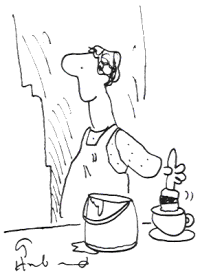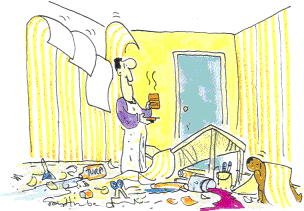Two Great British Obsessions – Tea and DIY
Colour

In addition, colour choice is related to lifestyle and fashion issues. Most people want to choose a colour scheme which fits with modern trends in fabrics – something, perhaps, that won't clash with the new Ikea sofa. They also communicate through colour choice, and indeed every other aspect of decoration, their social class allegiances, economic status and leisure preferences. No wonder choosing a colour scheme can be hard work.
For our first-time DIYers, the difficulty of deciding on such a scheme from the infinite number of permutations available was frequently highlighted. Generally, it was the female partner who had most influence, but often not without much argument, discussion and cups of tea. In other cases, personal preferences were subsumed by the need to compromise. It is for this reason that many houses have relatively little real colour in them at all, the creams and beiges reflecting harmonious resolution of conflicting desires. Even those couples who had agreed on a colour, such as yellow, as the dominant hue, were not spared further effort. Getting the 'right' yellow still needed much to-ing and fro-ing from store to store and evenings spent poring over colour charts.
Others in our sample 'borrowed' colour schemes they had seen in magazines or on television, but were still not sure that they had 'got it right' in many cases. Even holidays and trips away can provide inspiration: "We did the hall, stairs and landing in an orange colour which we first saw on a pub crawl around Dublin."
A small minority (4%) simply bought whatever colour was the cheapest or on special offer, preferring economy over design considerations. "We didn't know what we wanted until we came to this shop, but there was a good deal on this terracotta."
There were others for whom no ready-canned paint was good enough. These were the 12% who claimed that only by summoning a store assistant to the mixing machine and having specific amounts of pigment added to a base paint could they be sure of getting just the right colour. This is a lengthy process, not just in the store itself. Firstly, you have to study those strips of near-identical colours to determine the exact mix you require. Then, having made a mistake the first time – when applied to the living room wall, the colour seemed different – you repeat the exercise until either satisfaction or simple fatigue brings the process to a halt.
The interesting thing about mixer colour choice, borne out by a number of our informants, is that the final selection quite often bears an uncanny resemblance to a standard paint colour that you can buy for half the price. The fact that many people are prepared to go to such to lengths to end up with what is really, well, just magnolia, is a testament to the real function of DIY. It's not just about covering walls or banister rails with paint. It's about creating a home environment which we feel is uniquely ours, as demonstrated by the complex decisions that we have made.


